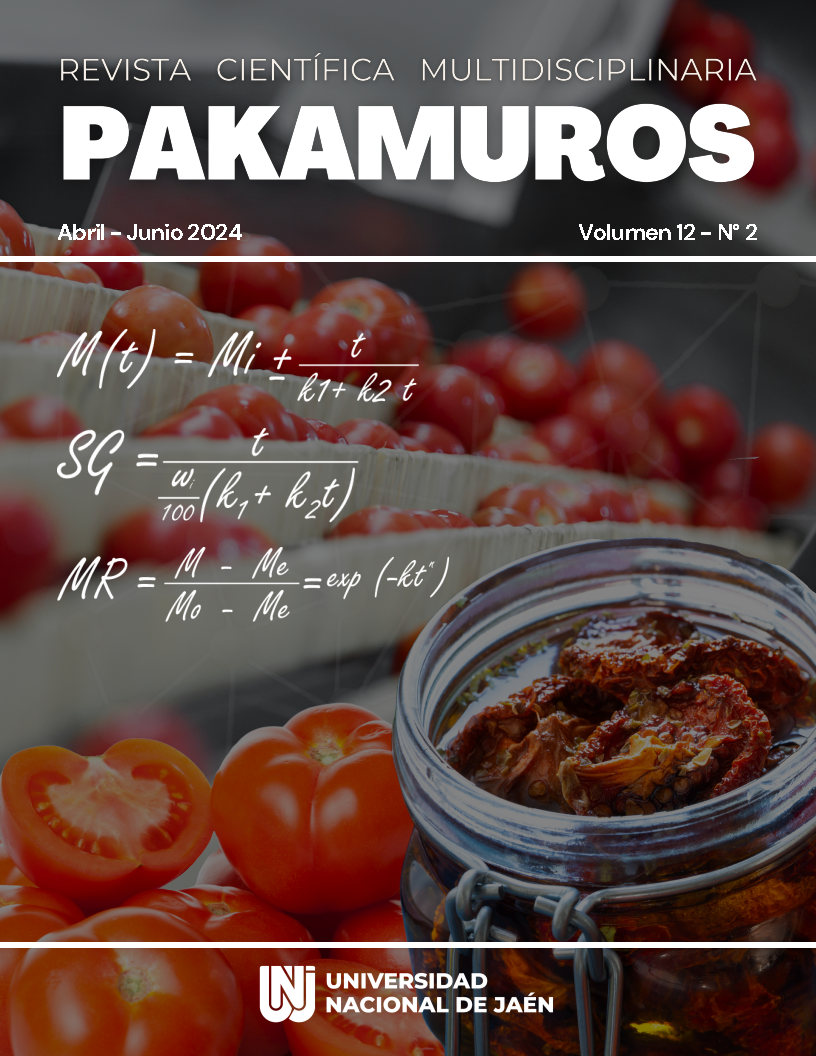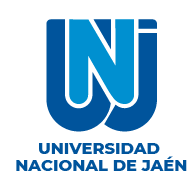Application of Peleg and Page's experimental models during osmotic dehydration and convective drying of tomato halves (Solanum lycopersicum L.)
DOI:
https://doi.org/10.37787/vakme596Keywords:
tomato, mass transfer, osmotic dehydration, drying, mathematical modelsAbstract
The phenomenon of mass transfer during osmotic dehydration and convective drying of tomato halves (Solanum lycopersicum L.) was carried out 1) using sucrose and salt as solutes; and 2) by fitting the Peleg and Page equations to the experimental data. The fruit was cut into halves and its seeds and placenta were removed. It was osmotically dehydrated with solutions: 10.8% 18% and 30% 50%, (w/v), of salt and sucrose respectively at a temperature of 25 °C. Subsequently, the resulting samples were subjected to a convective drying process by forced air in a tunnel at temperatures of: 50; 70 and 90ºC. Determining the weight loss of the samples, the solids gain, obtaining parameters from the experimental models of Peleg and Page with correlation levels of R2 ≥0.9894 for the proposed models.
References
Andritsos, N., Dalampakis, P., & Kolios, N. (2003). Use of geothermal energy for tomato drying. Oregon Institute of Technology Geo-Heat Center Bulletin.. https://bit.ly/4cuROk9
Aquino de los Santos C., Luján Hidalgo, M., Ventura Canseco., & Abud Archila, M.. (2023). Deshidratación osmótica de Carica papaya var. Maradol: Transferencia de masa y análisis sensorial. ESPACIO I+D: Innovación Más Desarrollo, 11(31). https://doi.org/10.31644/IMASD.31.2022.a08
Barat, J.M. 1998. Desarrollo de un modelo de la deshidratación osmótica como operación básica. [Tesis Doctoral, Universidad Politécnica de Valencia]. https://riunet.upv.es/bitstream/handle/10251/1834/tesisUPV2195.pdf?sequence=1
De Icaza Tena, G.. (2018). La Vida Útil de los Alimentos y sus Principales Reacciones. Innovación Editorial Lagares de México, S.A. de C.V. https://books.google.com.pe/books?id=llN1DwAAQBAJ&printsec=frontcover&hl=es&source=gbs_ge_summary_r&cad=0#v=onepage&q&f=false
Della-Rocca, P., & Mascheroni, R. (2011). Deshidratación de papas por métodos combinados de secado: deshidratación osmótica, secado por microondas y convección con aire caliente. Universidad Tecnologica Nacional, 9(2), 1–16. http://hdl.handle.net/11336/111733
Firdous, N., Khan, M. R., Butt, M. S., Ali, M., Asim Shabbir, M., Din, A., Hussain, A., Siddeeg, A., & Manzoor, M. F. (2022). Effect of Aloe vera gel-based edible coating on microbiological safety and quality of tomato. CyTA: Journal of Food, 20(1), 355–365. https://doi.org/10.1080/19476337.2022.2136760
Ganjloo, A., Rahman, R. A., Bakar, J., Osman, A., & Bimakr, M. (2012). Kinetics Modeling of Mass Transfer Using Peleg’s Equation During Osmotic Dehydration of Seedless Guava (Psidium guajava L.): Effect of Process Parameters. Food and Bioprocess Technology, 5(6), 2151–2159. https://doi.org/10.1007/s11947-011-0546-2
Ganjloo, A., Rahman, R. A., Bakar, J., Osman, A., & Bimakr, M. (2012). Kinetics Modeling of Mass Transfer Using Peleg’s Equation During Osmotic Dehydration of Seedless Guava (Psidium guajava L.): Effect of Process Parameters. Food and Bioprocess Technology, 5(6), 2151–2159. https://doi.org/10.1007/s11947-011-0546-2
García-Paternina, M., Alvis-Bermudez, A., & García-Mogollon, C. A. (2015). Evaluación de los Pretratamientos de Deshidratación Osmótica y Microondas en la Obtención de Hojuelas de Mango (Tommy Atkins). Información Tecnológica, 26(5), 63–70. https://doi.org/10.4067/S0718-07642015000500009
Gaware, T. J., Sutar, N., & Thorat, B. N. (2010). Drying of tomato using different methods: Comparison of dehydration and rehydration kinetics. Drying Technology, 28(5), 651–658. https://doi.org/10.1080/07373931003788759
Goula, A. M., & Lazarides, H. N. (2012). Modeling of mass and heat transfer during combined processes of osmotic dehydration and freezing (Osmo-Dehydro-Freezing). Chemical Engineering Science, 82, 52–61. https://doi.org/10.1016/j.ces.2012.07.023
Hawkes J., Flink J., (1978); Osmotic concentration of fruits slices prior to freeze dehydration. J. Food Proc. Preserv. 2, pags. 265-284 https://doi.org/10.1111/j.1745-4549.1978.tb00562.x
Hernández, P. L. B., Delgado, A. C. B., Sánchez, S. A. M., Castillo, H. S. V., & Porras, D. P. N. (2011). Efecto del recubrimiento a base de almidón de yuca modificado sobre la maduración del tomate. Revista Lasallista de Investigación, 8(2), 96–103. https://www.redalyc.org/pdf/695/69522607011.pdf
Lazarides, H.N.; Katsanidis, E. & Nickolaidis, A. (1995). Mass transfer kinetics during osmotic preconcentration aiming at minimal solid uptake. Revista de Ingeniería de Alimentos. 25(2), pags. 151-166. https://doi.org/10.1016/0260-8774(94)00006-U
Lewicki, P. P., Le, H. V., & Pomara N Nska-Łazuka, W. (2002). Effect of pre-treatment on convective drying of tomatoes. 1–6. www.elsevier.com/locate/jfoodeng
Li, H., Zhao, C., Guo, Y., An, K., Ding, S., & Wang, Z. (2012). Mass transfer evaluation of ultrasonic osmotic dehydration of cherry tomatoes in sucrose and salt solutions. International Journal of Food Science and Technology, 47(5), 954–960. https://doi.org/10.1111/j.1365-2621.2011.02927.x
Mariem, S., & Mabrouk, S. (2014). Drying Characteristics of Tomato Slices and Mathematical Modeling. International Journal of Energy Engineering, 2014(2A), 17–24. https://doi.org/10.5923/j.ijee.201401.03
Milacatl, V.; (2003); Cambios en atributos sensoriales y degradación de ácido ascórbico en función de la temperatura en puré y néctar de mango. [Tesis de grado. Universidad de las Américas. Puebla, México]. http://catarina.udlap.mx/u_dl_a/tales/documentos/lia/milacatl_h_v/
Hayes, W.A., Smith, P.G., Morris A.E., (2010). The production and quality of tomato concentrates. Crit.Rev. Food Sci. Nutr., 7, pags. 537-564. https://doi.org/10.1080/10408699891274309
Nowicka, P., Wojdyło, A., Lech, K., & Figiel, A. (2015). Influence of Osmodehydration Pretreatment and Combined Drying Method on the Bioactive Potential of Sour Cherry Fruits. Food and Bioprocess Technology, 8(4), 824–836. https://doi.org/10.1007/s11947-014-1447-y
Neumann, L. (2021). Tópicos En Microbiología E Inocuidad De Los Alimentos. RIL editores. https://www.digitaliapublishing.com/a/113096/topicos-en-microbiologia-e-inocuidad-de-los-alimentos
Obajemihi, O. I., Esua, O. J., Cheng, J. H., & Sun, D. W. (2023). Effects of pretreatments using plasma functionalized water, osmodehydration and their combination on hot air drying efficiency and quality of tomato (Solanum lycopersicum L.) slices. Food Chemistry, 406(November 2022), 134995. https://doi.org/10.1016/j.foodchem.2022.134995
Petrotos, K. B., & Lazarides, H. N. (2001). Osmotic concentration of liquid foods. Journal of Food Engineering, 49(23)(201–206), 1–6. https://doi.org/10.1016/S0260-8774(00)00222-3
Pinzon, M. I., Villa, C. C., & Nieto, J. A. (2011). Cambios de color y perfil aromático en soluciones osmóticas usadas en deshidratación osmotica de tomate de árbol. Biotecnología en el Sector Agropecuario y Agroindustrial 9(2), 121-129. http://hdl.handle.net/11336/190501
Sacchetti, G; Gianotti, A; Dalla Rosa, M.; (2001). Sucrose-salt combined effect on mass transfer kinetics and product acceptability. Study on apple osmotic treatment. Journal of Food Engineering, 47, 163-173. https://doi.org/10.1016/S0260-8774(00)00206-5
Suárez-Morales, J. A., Hernández-Arriola, D. G., Marín-Benítez, M. E., & Riera-González, G. (2021). Deshidratación osmótica de la piña var. española roja para su incorporación a una leche fermentada. Ciencia y Tecnologia de Los Alimentos, 31(2), 47–52. https://revcitecal.iiia.edu.cu/revista/index.php/RCTA/article/view/276/237
Villa, C. C., Nieto, J. A., & Pinzón, M. I. (2009). Cambios composicionales y microbiológicos asociados a ciclos sucesivos de deshidratación osmótica de tomate de árbol. Biotecnología en el sector agropecuario y agroindustrial, 7(1), 29–35. http://www.scielo.org.co/pdf/bsaa/v7n1/v7n1a05.pdf
Zou, K., Teng, J., Huang, L., Dai, X., & Wei, B. (2013). Effect of osmotic pretreatment on quality of mango chips by explosion puffing drying. Lwt, 51(1), 253–259. https://doi.org/10.1016/j.lwt.2012.11.005
Published
Issue
Section
License
Copyright (c) 2024 Pakamuros Scientific Journal

This work is licensed under a Creative Commons Attribution-NonCommercial 4.0 International License.













